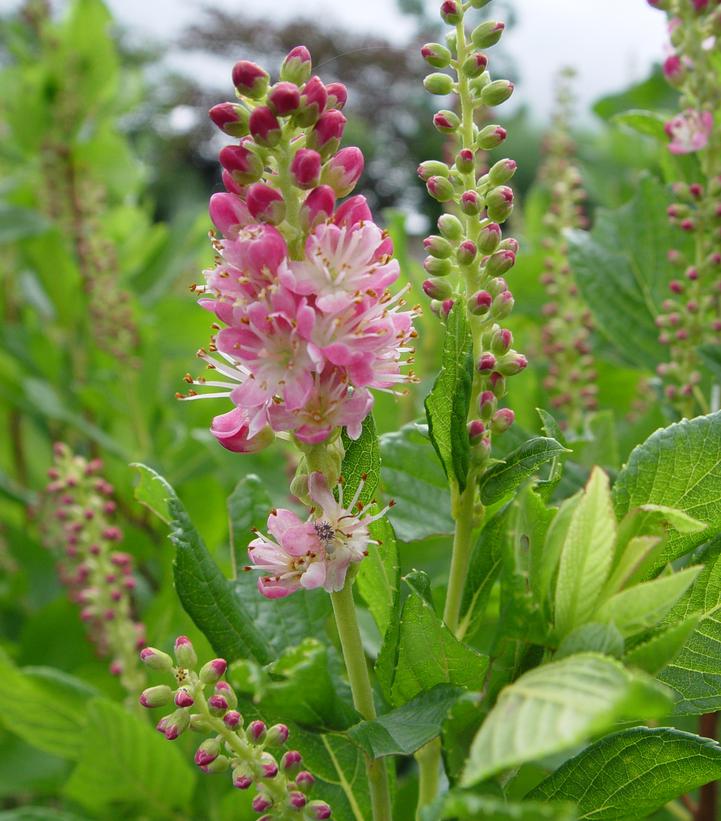Common Name: Ruby Spice Summersweet, Sweet Pepperbush
Bloom Time: Mid to late summer (July–August)
USDA Zones: 3–8
Mature Size: 3–5 ft tall × 3–5 ft wide
Introduction
When summer heat peaks and many spring-blooming shrubs have faded, Ruby Spice® Summersweet steps into the spotlight with its fragrant, rosy-pink flower spikes. This Proven Winners® introduction elevates the classic North American native Clethra alnifolia with bolder color and a more compact, rounded habit. Perfect for South East Wisconsin’s humid summers and cold winters, Ruby Spice® delights gardeners with irresistible fragrance—think honey and spice—and continuous bloom that attracts bees, butterflies, and hummingbirds. Whether you’re refreshing a foundation planting or creating a sensory border, this versatile shrub brings both beauty and function to the midsummer garden.
Origins and Description
Native to the wetlands and woodland edges of the eastern United States, Clethra alnifolia has long been valued for its summer fragrance and adaptability. The cultivar ‘Ruby Spice’ was introduced by Proven Winners® for its deeper-pink flower spikes that can reach up to 6″ long, contrasted against glossy, dark-green foliage. Unlike older selections that nod or hang, Ruby Spice® carries its blooms upright on sturdy stems, ensuring maximum visibility and extended display. Leaves are oval, finely toothed, and emerge fresh-green in spring, turning shades of gold and russet in autumn for additional seasonal interest.
Ideal Growing Conditions
-
Light: Thrives in full sun to part shade. In South East Wisconsin, aim for at least four hours of direct morning or filtered afternoon sun to balance bloom production with leaf health.
-
Soil: Prefers moist, organically rich, well-drained soils but tolerates clay, sand, and even temporarily wet ground—making it ideal for rain gardens or near water features. Amending planting holes with compost will jump-start growth.
-
Moisture: Native to damp habitats, Ruby Spice® performs best with consistent moisture. Once established, it withstands short dry spells, but supplemental summer watering ensures larger flower spikes and lush foliage.
-
Hardiness: Rated for USDA Zones 3–8, this shrub easily weathers Wisconsin’s winter lows (down to –30°F). A 2–3″ mulch ring in late fall protects root crowns from freeze–thaw heaving.
Planting and Establishment
-
Timing: Plant in spring after soils warm (mid-April to early May) or in early fall (late September) to allow roots to establish before extremes of summer heat or winter cold.
-
Site Preparation: Remove weeds and grass to reduce competition. Dig a hole twice as wide as the root ball and just as deep; backfill with existing soil amended up to 25% compost.
-
Planting: Position the crown even with the surrounding grade. Gently firm soil around roots, water thoroughly, and apply a 2″–3″ layer of shredded hardwood mulch—keeping it an inch from the stems to prevent rot.
-
Watering: During the first season, aim for 1″ of water per week (rainfall plus supplemental irrigation). This encourages deep, healthy root growth that supports drought tolerance later on.
Care and Maintenance
-
Watering: Maintain consistent soil moisture through midsummer. Use a soaker hose or drip irrigation to reduce leaf wetness and minimize disease risk.
-
Fertilization: In spring, apply a balanced, slow-release shrub fertilizer according to label rates. Avoid high-nitrogen blends that promote leafy growth at the expense of blooms. A second, lighter feeding in midsummer can boost late-season flowering if growth appears sluggish.
-
Mulching: Refresh mulch annually to suppress weeds, regulate soil temperature, and retain moisture.
-
Pest & Disease: Ruby Spice® is generally pest-free and resists deer browsing. Good air circulation and proper spacing (3–5′ apart) help prevent powdery mildew in humid conditions.
Pruning and Propagation
-
Pruning: Since Summersweet blooms on the previous year’s wood, prune immediately after flowering (late August). Remove up to one-third of the oldest stems at ground level to encourage fresh shoots. Lightly trim for shape, but avoid late-season cuts that sacrifice next year’s buds.
-
Propagation: Softwood cuttings in early summer can root readily under bottom heat, but most gardeners prefer reliable container liners from a reputable nursery to guarantee ‘Ruby Spice’ characteristics.
Landscape Uses and Companions
-
Hedges & Screens: Line plants 3–4′ apart for a low hedge that perfumes the air and provides summer privacy.
-
Rain & Pollinator Gardens: Its tolerance for moist soils and nectar-rich flowers make it a standout in rain gardens or wildlife-friendly plantings.
-
Foundation Accents: Underplant with shade-tolerant perennials like hostas (Hosta spp.) and ferns (Matteuccia struthiopteris) to soften structural elements.
-
Companion Plants: Pair with late-summer bloomers such as ornamental grasses (Panicum virgatum), Japanese anemone (Anemone × hybrida), and sedums (Sedum ‘Autumn Joy’) for layered texture and staggered color.
Conclusion
Ruby Spice® Summersweet is a must-have for South East Wisconsin gardeners seeking fragrance, pollinator appeal, and reliable performance in a compact package. Its rosy-pink blooms, tolerance for varied soil conditions, and easy maintenance make it a go-to choice for borders, rain gardens, and foundation plantings alike.

